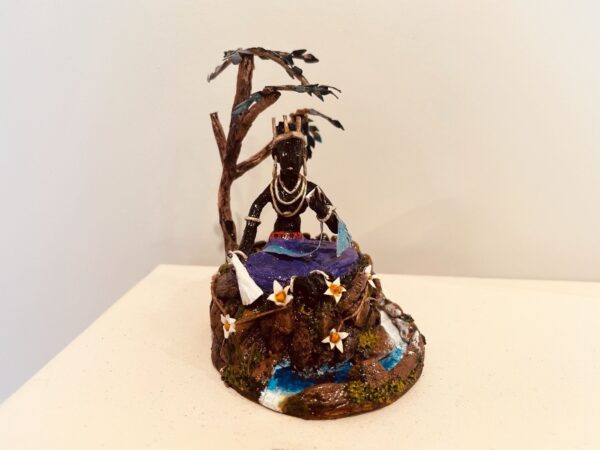by Charles Finney
I am truly grateful that you have given me the chance to showcase my paper craft. I came to that because of the two different techniques I use to create a piece. It’s like paper mâché, except I use a lot of the same techniques one would use while molding clay or even carving wood so I can add expression and movement to a piece.
When I started on the Black Tara, it automatically took on a life of its own. Because I had never made anything before, that required so much detail to bring it into perspective, each little piece I added took me to the next. Like it was making itself. Sadly I ran out of material before I ran out of ideas. Because I’m on death row, I have to use Q-tips to frame the piece and paper towels, card stock, Elmer’s glue (gloss when I can get it). They don’t sell us glue and gloss anymore, so I have to buy it off of the old guys, who still have some of the old hobby craft items. In here that can cost a lot just for a couple of grams or a trade in talent depending on the seller. They usually want something made for more than the amount of supplies they’re willing to give up.
I’m on a closed wing and in a one-man cell, so I have to go through someone to obtain whatever I need—kinda like having a middle man on the street. It costs more to live in prison than it does on the street.
I came from a small town in Georgia. Macon is about 90 miles outside of Atlanta. I didn’t develop an interest in fine arts until high school, but I grew up learning the fine art of woodworking under my dad and uncles. They were cabin makers and home builders by trade. At thirteen, I started working on a cabin by myself and started working undercover for a construction company. In those days, there weren’t very many skilled jobs available to blacks—except undercover for less pay. But we were poor and everyone in my family had to work to eat and pay bills. When my father died I was fifteen. I had to drop out of school and get another job to help out my family. My mother had fallen prey to alcoholism after my stepfather died. He, too, had a long history of alcoholism. I had two siblings older than me, but we all lived very different lives—rather dysfunctional is a better way to describe it.
Artwork has always been a refuge for me—especially at this stage of my life. It speaks for me in ways where people will finally hear me without judging who I am or what I am… that to me is the purpose of the Black Tara. It’s who and what she represents in this world… freedom to exist.
An artist and incarcerated Soulmaker on death row in Florida, Charles Finney creates sculptures from paper, Q-tips, and other found objects.

 Get access to the monthly Rehumanization Magazine featuring contributors from the front lines of this effort—those living on Death Row, residents of the largest women’s prison in the world, renowned ecologists, the food insecure, and veteran correctional officers alike.
Get access to the monthly Rehumanization Magazine featuring contributors from the front lines of this effort—those living on Death Row, residents of the largest women’s prison in the world, renowned ecologists, the food insecure, and veteran correctional officers alike.